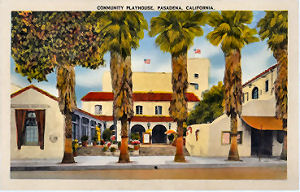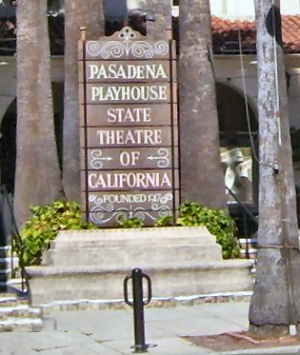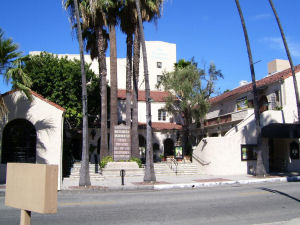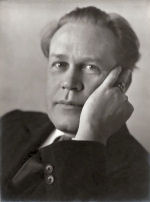State Theater of California
| Pasadena Playhouse |
|
Adopted:1937 |
Adoption of the State Theater of California
Gilmore Brown, born in North Dakota in 1886, established a diverse career in the theater before he found a permanent home for his troupe, "The Gilmore Brown Players," in 1916 Pasadena, California.
Theater company manager, director, and actor, Brown established the Community Playhouse Association of Pasadena (later, the Pasadena Playhouse Association) in 1917. The "Community Players" offered performances in available facilities throughout Pasadena, including the Savoy Theater, a renovated burlesque house.
In May, 1924, the cornerstone was laid for the new Pasadena Community Playhouse at 39 South E1 Molino Avenue. The theater was designed in a Spanish Colonial Revival style by Pasadena artist and architect Elmer Grey.
 |
Pasadena Playhouse: State Theater of California
Pasadena Playhouse prints |
 |
Welcome to the Pasadena Playhouse, State Theater of California
Founded 1917 |
One year later, the Pasadena Community Playhouse opened under the direction of Gilmore Brown. Thus began what are referred to as the golden years (1925-1937) of the Pasadena Community Playhouse.
The theater earned early international stature with a production of Eugene O'Neill's "Lazarus Laughed" in 1929. During the golden years, the Playhouse produced more than 500 new plays, including 23 American and 277 world premieres.
Also during this time, in 1928, Gilmore Brown established the Pasadena Playhouse College of Theater Arts, awarding Bachelor's and Master's of Arts degrees in combined study with another academic institution. The College of Theater Arts offered classes in acting, speech, directing, production, and the history and literature of drama.
Countless numbers of playwrights, directors, and actors such as Jamie Farr, Gene Hackman, Dustin Hoffman, William Holden, Rue McClanahan, and Sally Struthers received some of their early training at the theater school.
In 1937, the Pasadena Playhouse Association was incorporated as a non-profit organization and the Pasadena Playhouse was accorded the honorary title of "State Theater of California" by the California Legislature for bringing national and international renown to the state as a center of dramatic art. It was reported on the Atlantic Coast in the March 30, 1937 issue of the New York Times
With considerable pride the Pasadena Playhouse announces that it has received the title "State theater of California" from the Legislature. No financial concessions or official supervision. Just recognition.
Gushing, and interestingly prescient, Tempe E. Allison wrote of the Pasadena Playhouse in the Times on August 22, 1937,
The Pasadena Playhouse...theatrical refreshment in this dust bowl, if not desert, of the legitimate stage, which has been sucked dry by the gigantic growth of its next-door neighbor, Hollywood.
 |
| Pasadena Playhouse, 39 South E1 Molino Avenue |
Writing of the Playhouse's summer program
...annual excursions to Broadway demonstrate that, by and large, as stimulating and provocative plays are available in this playhouse as in a Broadway season, and several Summers of Eastern and European drama festivals indicate that, on the whole, the Midsummer Drama Festival at Pasadena equals the levels of achievement which obtain at Stratford, Malvern, or Moscow.
The glory days were numbered however and, due to a proliferation of theaters in Los Angeles, the establishment of other drama schools, the arrival of television, and the death of Gilmore Brown in 1960, the Pasadena Playhouse's fortunes began to recede.
In 1969, the theater was closed and in 1970, the Pasadena Playhouse Association and the College of Theater Arts were dissolved.
For sixteen years, the theater lived in limbo, vacant. Efforts to re-establish a community theater were unsuccessful. Developers and the wrecking ball were held at bay and on November 11, 1975, the Pasadena Playhouse was listed on the National Register of Historic Places as an "Excellent example of Spanish Colonial style" and "example of the work of noted Los Angeles architect Elmer Grey.
By 1979, the theater's prospects were on the rise. The city of Pasadena purchased the structure and obtained a grant from the Economic Development Agency and began restoration.
The Pasadena Playhouse reopened in 1986 and, as one of the oldest professionally operated theaters in the state, it continues in a new century with a dedication to the development and presentation of culturally diverse variety of theatrical productions at the highest level of artistry.
The ghost of Gilmore Brown, rumored to spend his time in his old third floor office, would be pleased.
Source: California State Library: History and Culture, State Symbols, March 12, 2008.
Source: The New York Times, News of the Stage, March 30, 1937.
Source: The New York Times, Pasadena does a cycle, August 22, 1937.
Source: The Sunday Herald, Old Pasadena Playhouse is staging its own revival, October 21, 1979.
Source: State Names, Seals, Flags and Symbols: A Historical Guide Third Edition, Revised and Expanded by Benjamin F. Shearer and Barbara S. Shearer. Greenwood Press; 3 Sub edition (October 30, 2001).
Additional Information
Pasadena Playhouse:
The official website of the Pasadena Playhouse.
Ticket City:
Purchase tickets to productions at the Pasadena Playhouse.
Pasadena Playhouse:
Entry in Wikipedia, the free encyclopedia.
Alumni and Associates:
Pasadena Playhouse alumni and associates page with an unique historical perspective of the theater.
The Pasadena Playhouse: A Celebration of One of the Oldest Theatrical Organizations in America,
by Judy O'Sullivan, Theatre Corp of America (July 1992).
Tasty Productions,
by Lenore Bond Almanzar, Spiral-bound. Friends of the Pasadena Playhouse (1989).
Hometown Pasadena: The Insider's Guide,
by Colleen Dunn Bates, Jill Alison Ganon, Sandy Gillis, Mel Malmberg, Mary Jane Horton, 256 pages, Prospect Park Books (October 4, 2006)
The Pasadena Insider's City Guide, Third Edition,
by Martha Annee Shenkenberg; 3rd edition (March 14, 2005).
|





